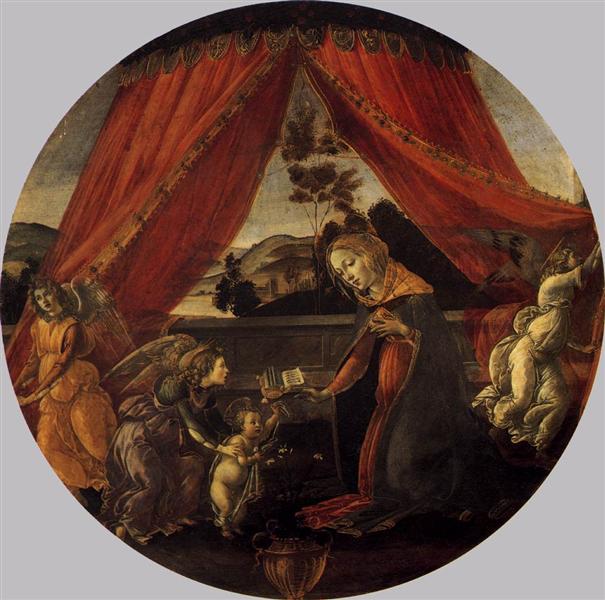Description
The work "Madonna and Child with Three Angels", painted by Sandro Botticelli in 1493, stands as a paradigmatic example of Renaissance art, notable not only for its aesthetic beauty but also for its ability to capture spirituality and humanity. Botticelli, a master of the Florentine brush, is known for his talent for infusing a sense of movement and emotion into his compositions; attributes that can be clearly observed in this painting.
The Virgin Mary occupies the centre of the composition, surrounded by three angels, allowing for a fluid and balanced circulation of the pictorial space. She holds the infant Christ in her arms, which gives the work its iconic theme. The Virgin's posture is maternal and protective, reinforced by the way her body leans towards her son expressing both love and a sense of devotion. This human touch is in perfect harmony with the idealisation of the figures, a distinctive trait of Botticelli, who often composes his characters with an ethereal beauty that transcends their earthly context.
The angels accompanying the Virgin, arranged so that each of them seems to represent different attitudes and emotions, add a dynamic dimension to the work. Their faces are serene and contemplative, and their expressions, though soft, suggest a deep sense of adoration. Here, Botticelli achieves a delicate balance between the celestial and the human, a central theme in religious art of the time. The choice to place the angels in a position of reverence towards the Virgin emphasizes her role as a central figure of the Christian faith.
The use of color in this painting is equally notable. The rich, saturated palette Botticelli employs results in a luminous atmosphere that highlights the divine features of the Virgin and the angels. Mary's fair skin contrasts with the darker background and the more intricate clothing of the angels, who wear robes of soft hues that complement their presence and lend a sense of unity to the composition. The meticulously crafted details of the clothing, along with the texture of the skin and hairstyles, reflect Botticelli's distinctive style in the depiction of the human figure.
The historical context in which Botticelli created this work adds another layer of meaning. His style is integral to the transition between the late Gothic and the full Renaissance, where humanistic ideals begin to take shape in art, opening up a space where religious beliefs intertwine with the exploration of individuality and perspective. This balance is crucial, as the work not only seeks to pay homage to divinity, but also allows for a connection with the human and the emotional.
Finally, although this specific work is not one of Botticelli's best-known works like The Birth of Venus or Primavera, Madonna and Child with Three Angels represents a significant moment in the artist's career, where his ability to combine the sacred with the human becomes evident. The delicate execution and deep emotional resonance of the painting invite us to reflect not only on religious iconography, but also on art's ability to connect the spiritual with the human experience. In this sense, Botticelli remains one of the greatest exponents of the Renaissance, whose work continues to inspire admiration and contemplation today.
KUADROS ©, a famous painting on your wall.
Hand-made oil painting reproductions, with the quality of professional artists and the distinctive seal of KUADROS ©.
Painting reproduction service with satisfaction guarantee. If you are not completely satisfied with the replica of your painting, we will refund 100% of your money.

